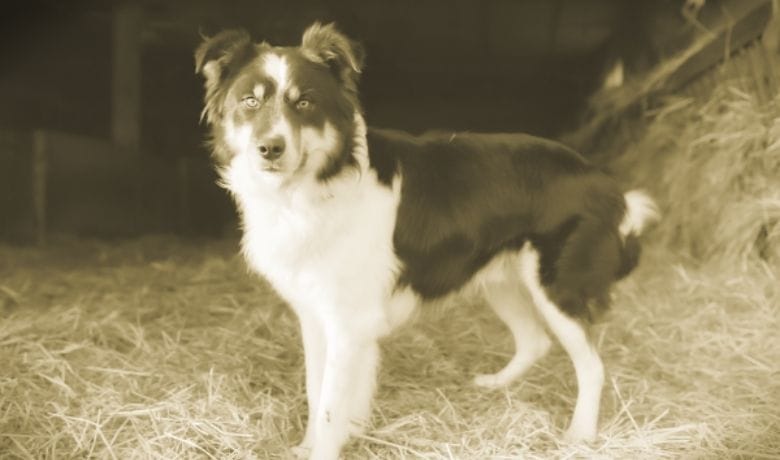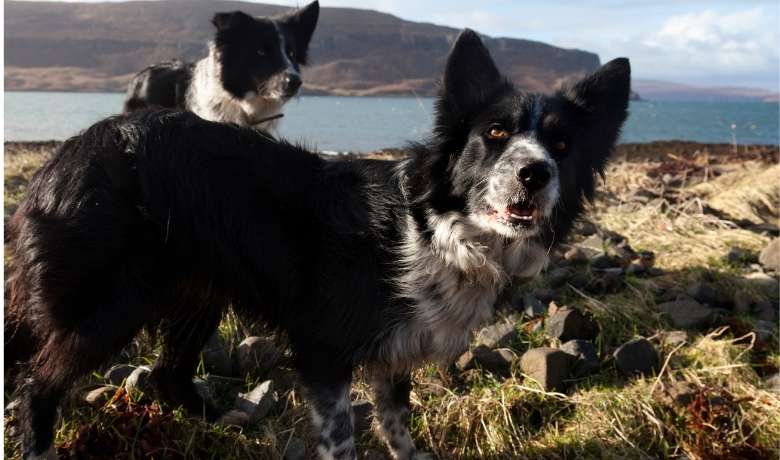For centuries, Collies have been used for herding sheep on farms and ranches all over the world. The Border Collie originates from an ancient breed of dog that has evolved and lived side by side with humans for hundreds of years – as in the present they continue to be one of the most popular breeds in America, UK and beyond. Little is known about their exact origins, but a lot can be inferred from studying old records and the instincts of collies that hark back to their work as service dogs.
Where do Border Collies come from? They originate from Scotland. The Border Collie is an old breed, with its earliest mention coming from the 19th Century. The Border Collie originated in the Scottish Borders region of Scotland, hence their name which means “dweller” or “worker” on the border. Though there are records dating back to that era describing a dog type similar to today’s Border Collies, and the first dog show at which they were exhibited was in 1873.
The Border Collie boasts a strong herding instinct that can be traced back to its roots in Scotland. These were all-around farm dogs who herded any animals being raised on the small farms such as chickens and sheep. Their intelligence and instincts made training them easier at an early age, putting them to work during what was and is a hard (and often short) life of service. Here we explore the origins of our beloved Collie and what in the past made them the dogs we love today.
Where Do Border Collies Come From?
Border Collies today, just like other domesticated dogs, are now part of our everyday lives and an important part of our families. But thinking back to your dog’s parents, grandparents, great grandparents etc etc… eventually you will end up with a Scottish dog. Your Collies’ ancestor came from Scotland where this breed originated, including the Scottish border. Of course, they often had Celtic names as a result!
The Border Collie breed is believed to be descended from the same ancestors as all other collies. It’s unclear when people started calling them “border” collies, but it is likely to have been because they were used for herding along the border between Scotland and England in the 19th Century. Collie is believed to be related to ‘worker’ or ‘dweller’ which would indeed make sense, although we have been unable to find a 100% reference source for this.
They are now one of the most popular breeds in the world, especially for dog sports like agility and sport herding activities. Helped by the fact that due to their origin, collies are so smart!
Border Collie Origin: From Wolves to Shepherds
Are Border Collies Related To Wolves?
Are Border Collies related to wolves? If we go back far enough, the ancestors of all Border Collies and other breeds of dog are of course Wolves! Selective breeding by humans took place, taking some of the more tame and less aggressive wolves (which may have begged for scraps around the neolithic caves and huts) and breeding them to eventually produce the smaller, friendlier and domesticated ancestors of the dogs we see today.
Sheepdogs of similar type are even found in ancient rock drawings depicting sheep farming during times when agriculture was just being introduced to Britain and Europe.
SO, let’s explore the ancient – and more recent – origins of Border Collies further, with a timeline we have put together. Accounts vary, but this is or best effort to trace the origins of collies from their roots in Scotland and the borderlands.
20-30,000 BC: Domestication
Dogs have been a loyal companion to people for centuries. But when were dogs domesticated? Scientists believe that dogs and wolves diverged between 36,900 to 41,500 years ago. This means that dogs would have been domesticated between 20,000 years to 32,000 years ago. One of the most popular theories is that wolves began following hunter-gatherer groups in order to scavenge off their kills and over time developed into the best friend we know today.
Now, we leap forward in time after many 100s of generations of breeding, leaning more towards the Collie-like dogs we recognize today:
1700 – 1800s: Industrial Revolution
The ancestors of the Border Collie were likely sheepdogs who guarded and herded livestock as well as nipping at their ankles as a way to move them. As these dogs traveled with different flocks, they picked up useful herding behaviors.
Their working ability could depend on the kind of livestock they were trying to herd, as well as how it was separated and if there were any predators nearby. With the Industrial Revolution came urbanization and a need for more dog breeds to help control their sheep in confined areas. This caused breeders to selectively breed for certain instincts, such as the ability to round up sheep in a pen.
1850 – 1860: “Old Hemp”
One of the earliest historical references to these dogs is from a shepherd’s prayer that appeared in “Blackwood’s Magazine” in 1850:
“Now then let us ha’e a grace an’ a blessin’, Guid Lord! for our sheep an’ thy dogs, for the bonny bield whaur they’re penned, an’ the halesome parritch thou sends them”
In 1860, a cattleman named Dobie of Binbirk farm in Scotland kept a dog called “Old Hemp.” His son William went to the Northumberland Sheepdog trials and saw dogs he believed were similar, so he bought one. This dog was bred to local working dogs and sheepdogs primarily of Collie type, and the result was a dog called “Old Bob.” Old Hemp’s great-grandson, Hemp, is said to be the father of all Border Collies.
1860 – 1870s: Royal Blood
In the 1860s and 1870s, some shepherds began to notice that some of their dogs would work with both sheep and cattle on hillsides, while other breeds only worked either one or the other. These Collies were said to be able to turn and control the sheep in their charge.
The first recorded use of these dogs in herding sheep flocks on English hillsides was by Prince Albert Victor, Duke of Clarence (1864–1892), a grandson of Queen Victoria, when he brought them back from the Scottish Borders c. 1876. The dogs were put to work at Balmoral, where they worked the sheep so well that the Scottish shepherds became known as “the Royal Dogs.”
1880 – 1890s: The First Border Collie
The Duke’s success led many others to experiment with these dogs, which were acquired by various breeders and farmers. One of those was William Skene, a Scottish lawyer, historian and antiquary (1809 –1892). There were other breeds in Britain at the time that could herd sheep, such as the English Shepherd and Bearded Collie. The latter breed is now extinct; however, a modern descendant is said to be the Pyrenean Mountain Dog (Great Pyrenees). As others became exposed to these working dogs, effort was put into breeding them for specific, desired traits.
Some early Border Collie breeders were William Edmond, Mark .Bury, R B Cruft and Adam Telfer.
The first recorded use of the term “Border Collie” was in a letter written by W J E Coates, a colliery manager from Northumberland. It was published in the “English Illustrated Magazine” in 1888. The first registration of Border Collies was done by the UK Kennel Club (UKC) in 1891; however, they were not fully recognized as a breed until 1903, when they were included in the “Stud Book.”
The standard for their conformation was drawn up and put into effect, the first written description having been provided by William Arkwright.

Border Collies in the US
Another top dog has been added to the list of most popular breeds in America! The Border Collie has come in at number six, beating out other high-energy dogs like the Jack Russell terrier and Dalmatian (however, popularity lists vary and this is not really that important of course!).
Border Collies were brought into the United States in the 1930s. Today they continue to grow in popularity with American families because of their intelligence and loyalty. Famously, James Dean had a very loyal Collie, often by his side!
In 1995 the Border Collie became a recognized American Kennel Club breed making it the 139th breed of the Kennel Club. They give the breed standards on physical appearance with this breed measuring 18-21 inches at the shoulders making it a medium-sized dog. This breed can come in many different colors with their double coat being either a smooth or rough coat. The Kennel Club recognizes the high energy level of this breed too suggesting it best suited to prospective owners who have a lot of time to devote to this extremely intelligent active breed.
The American Border Collie Association, established in 1983, holds information on both the breeding stock and breeding programs in North America. It also provides information on sporting herding events such as sheepdog trials in which handlers and dogs get to practice the herding skills still used in today’s agricultural practice.
Border Collies In Britain
Britain is a land of dog lovers. In fact, the UK has one of the highest rates of pet ownership in Europe. The most popular breeds amongst Brits include Labrador Retrievers and Border Collies – both originally bred for herding livestock. But it’s not just farmers who love these intelligent working dogs; they’re also fantastic family pets with a fun personality to boot! With their friendly nature, keen intelligence, and amazing work ethic, collies make excellent companions for anyone looking for an active canine companion. However, these traits can make them difficult to train if they don’t have the proper guidance from an early age.
A lot of people think that the border collie breed was created when the English herded Scottish sheep, but it turns out that they’ve just made great partners for each other! There is no evidence to support either claim. People have been using dogs since ancient times to help them with their farming and herding. It’s probably that Scottish and English farmers bred different dogs together to make the border collie we know today!
The International Sheep Dog Society allows prospective owners to check the pedigree of a Border Collie with some dogs being able to be traced back 100 years. holds information on the club standards required to host international sheepdog trails. For example, Wiston Cap an international champion in 1965, a tri-color Collie with dark brown eyes help set the standard for the breed. Wiston Cap’s bloodline can be traced in many Collies of the twentieth century.
See also the Border Collie Club of Great Britain and the Border Collie Trust GB.
Border Collies Today
As stated, the Border Collie is a herding breed with origins in the pastoral areas of northern England and Scotland, they have been used to herd sheep for hundreds of years. These medium-sized dogs with a double coat, smooth coat and their intelligence, agility, energy, and trainability.
They are also increasingly popular as pets and via training can perform many different tasks and canine activities that require high levels of intelligence.
Every experienced owner knows that Border Collies are smart with a need for physical exercise and mental stimulation. As a Border Collie owner, it is vital to build a good daily routine. This routine should consist of daily exercises such as going on a long walk with their active owner and brain exercise which can be achieved through plenty of activities that nurture its natural instinct.
In addition to this, the Border Collie coat type needs regular grooming. This daily exercise helps to keep your Border Collie happy and healthy and hopefully avoid conditions such as hip dysplasia that can be common in this herding dog breed.
